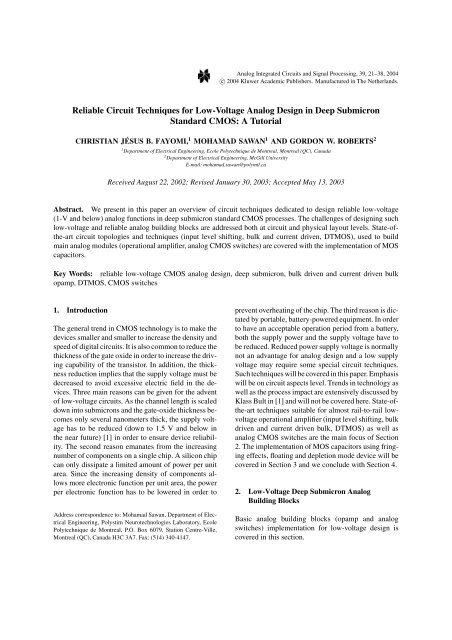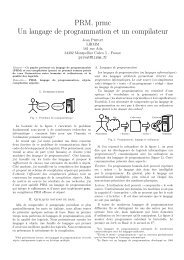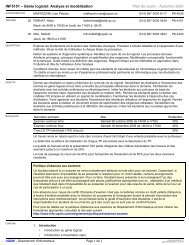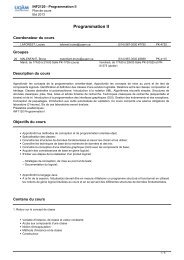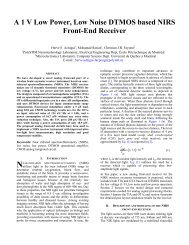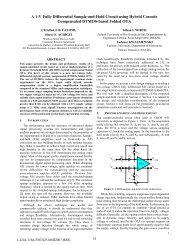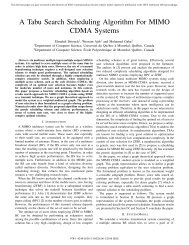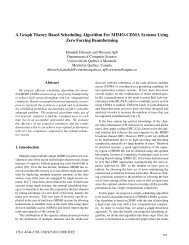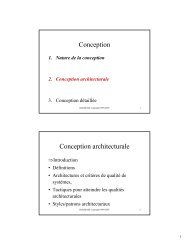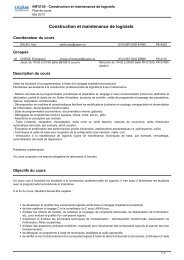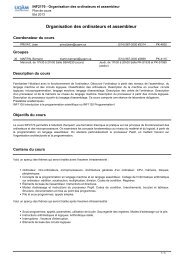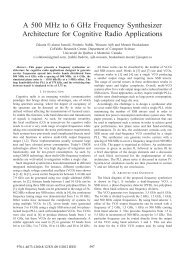Reliable Circuit Techniques for Low-Voltage Analog Design in Deep ...
Reliable Circuit Techniques for Low-Voltage Analog Design in Deep ...
Reliable Circuit Techniques for Low-Voltage Analog Design in Deep ...
Create successful ePaper yourself
Turn your PDF publications into a flip-book with our unique Google optimized e-Paper software.
<strong>Analog</strong> Integrated <strong>Circuit</strong>s and Signal Process<strong>in</strong>g, 39, 21–38, 2004<br />
c○ 2004 Kluwer Academic Publishers. Manufactured <strong>in</strong> The Netherlands.<br />
<strong>Reliable</strong> <strong>Circuit</strong> <strong>Techniques</strong> <strong>for</strong> <strong>Low</strong>-<strong>Voltage</strong> <strong>Analog</strong> <strong>Design</strong> <strong>in</strong> <strong>Deep</strong> Submicron<br />
Standard CMOS: A Tutorial<br />
CHRISTIAN JÉSUS B. FAYOMI, 1 MOHAMAD SAWAN 1 AND GORDON W. ROBERTS 2<br />
1 Department of Electrical Eng<strong>in</strong>eer<strong>in</strong>g, Ecole Polytechnique de Montreal, Montreal (QC), Canada<br />
2 Department of Electrical Eng<strong>in</strong>eer<strong>in</strong>g, McGill University<br />
E-mail: mohamad.sawan@polymtl.ca<br />
Received August 22, 2002; Revised January 30, 2003; Accepted May 13, 2003<br />
Abstract. We present <strong>in</strong> this paper an overview of circuit techniques dedicated to design reliable low-voltage<br />
(1-V and below) analog functions <strong>in</strong> deep submicron standard CMOS processes. The challenges of design<strong>in</strong>g such<br />
low-voltage and reliable analog build<strong>in</strong>g blocks are addressed both at circuit and physical layout levels. State-ofthe-art<br />
circuit topologies and techniques (<strong>in</strong>put level shift<strong>in</strong>g, bulk and current driven, DTMOS), used to build<br />
ma<strong>in</strong> analog modules (operational amplifier, analog CMOS switches) are covered with the implementation of MOS<br />
capacitors.<br />
Key Words: reliable low-voltage CMOS analog design, deep submicron, bulk driven and current driven bulk<br />
opamp, DTMOS, CMOS switches<br />
1. Introduction<br />
The general trend <strong>in</strong> CMOS technology is to make the<br />
devices smaller and smaller to <strong>in</strong>crease the density and<br />
speed of digital circuits. It is also common to reduce the<br />
thickness of the gate oxide <strong>in</strong> order to <strong>in</strong>crease the driv<strong>in</strong>g<br />
capability of the transistor. In addition, the thickness<br />
reduction implies that the supply voltage must be<br />
decreased to avoid excessive electric field <strong>in</strong> the devices.<br />
Three ma<strong>in</strong> reasons can be given <strong>for</strong> the advent<br />
of low-voltage circuits. As the channel length is scaled<br />
down <strong>in</strong>to submicrons and the gate-oxide thickness becomes<br />
only several nanometers thick, the supply voltage<br />
has to be reduced (down to 1.5 V and below <strong>in</strong><br />
the near future) [1] <strong>in</strong> order to ensure device reliability.<br />
The second reason emanates from the <strong>in</strong>creas<strong>in</strong>g<br />
number of components on a s<strong>in</strong>gle chip. A silicon chip<br />
can only dissipate a limited amount of power per unit<br />
area. S<strong>in</strong>ce the <strong>in</strong>creas<strong>in</strong>g density of components allows<br />
more electronic function per unit area, the power<br />
per electronic function has to be lowered <strong>in</strong> order to<br />
Address correspondence to: Mohamad Sawan, Department of Electrical<br />
Eng<strong>in</strong>eer<strong>in</strong>g, Polystim Neurotechnologies Laboratory, Ecole<br />
Polytechnique de Montreal, P.O. Box 6079, Station Centre-Ville,<br />
Montreal (QC), Canada H3C 3A7. Fax: (514) 340-4147.<br />
prevent overheat<strong>in</strong>g of the chip. The third reason is dictated<br />
by portable, battery-powered equipment. In order<br />
to have an acceptable operation period from a battery,<br />
both the supply power and the supply voltage have to<br />
be reduced. Reduced power supply voltage is normally<br />
not an advantage <strong>for</strong> analog design and a low supply<br />
voltage may require some special circuit techniques.<br />
Such techniques will be covered <strong>in</strong> this paper. Emphasis<br />
will be on circuit aspects level. Trends <strong>in</strong> technology as<br />
well as the process impact are extensively discussed by<br />
Klass Bult <strong>in</strong> [1] and will not be covered here. State-ofthe-art<br />
techniques suitable <strong>for</strong> almost rail-to-rail lowvoltage<br />
operational amplifier (<strong>in</strong>put level shift<strong>in</strong>g, bulk<br />
driven and current driven bulk, DTMOS) as well as<br />
analog CMOS switches are the ma<strong>in</strong> focus of Section<br />
2. The implementation of MOS capacitors us<strong>in</strong>g fr<strong>in</strong>g<strong>in</strong>g<br />
effects, float<strong>in</strong>g and depletion mode device will be<br />
covered <strong>in</strong> Section 3 and we conclude with Section 4.<br />
2. <strong>Low</strong>-<strong>Voltage</strong> <strong>Deep</strong> Submicron <strong>Analog</strong><br />
Build<strong>in</strong>g Blocks<br />
Basic analog build<strong>in</strong>g blocks (opamp and analog<br />
switches) implementation <strong>for</strong> low-voltage design is<br />
covered <strong>in</strong> this section.
22 Fayomi, Sawan and Roberts<br />
2.1. <strong>Low</strong>-<strong>Voltage</strong> Operational Amplifier<br />
One of the most important basic build<strong>in</strong>g blocks <strong>in</strong><br />
analog and mixed-mode circuits is the operational<br />
amplifier. In a low-voltage (LV) opamp, the m<strong>in</strong>imum<br />
supply value is imposed by the differential pair of the<br />
<strong>in</strong>put stage and is equal to the threshold voltage (V th )<br />
plus two overdrive voltages (V DSat ). In typical CMOS<br />
processes, this value turns out to be around 1-V. On<br />
the other hand, the ma<strong>in</strong> limitation of differential pairs<br />
is the reduced <strong>in</strong>put common-mode range (ICMR). In<br />
order to m<strong>in</strong>imize the supply requirements of the <strong>in</strong>put<br />
stage, both <strong>in</strong>put term<strong>in</strong>als of an opamp must work<br />
with potentials very close to one of the supply rails. To<br />
overcome this limitation, several schemes <strong>for</strong> discretetime<br />
(switched) operation with a s<strong>in</strong>gle supply down to<br />
1Vand large output signal sw<strong>in</strong>gs have been recently<br />
reported [2–10]. The switched-opamp (SO) technique<br />
[2] has been shown to be a promis<strong>in</strong>g low-cost solution<br />
to realize switched-capacitor (SC) circuits <strong>in</strong> standard<br />
CMOS processes. The SO elim<strong>in</strong>ates critical MOS<br />
switches that set the m<strong>in</strong>imum supply voltage to allow<br />
sub-1-V operation of the SC circuits [4] and, thus,<br />
does not have a reliability problem. S<strong>in</strong>ce then, a few<br />
modifications have been proposed to improve the per<strong>for</strong>mance<br />
of the SO techniques <strong>in</strong> terms of operation<br />
speed and compatibility with exist<strong>in</strong>g SC circuits.<br />
In switched applications, no <strong>in</strong>put sw<strong>in</strong>g is required<br />
<strong>for</strong> the opamp s<strong>in</strong>ce both <strong>in</strong>put term<strong>in</strong>als operate at<br />
one of the supply rails. Many others 1 V opamps<br />
are cont<strong>in</strong>uous-time <strong>for</strong> differential operation but use<br />
switches <strong>for</strong> the common-mode. Those techniques will<br />
not be covered <strong>in</strong> this paper. Most of cont<strong>in</strong>uous-time<br />
techniques will be addressed and can be classified <strong>in</strong><br />
three categories. The first technique is mostly based<br />
on level shift<strong>in</strong>g of the common <strong>in</strong>put signal to a<br />
value capable of driv<strong>in</strong>g the <strong>in</strong>put term<strong>in</strong>als [11–18].<br />
Cont<strong>in</strong>uous-time and switched-capacitor techniques<br />
have been developed to shift the <strong>in</strong>put. The second<br />
concept makes use of the bulk-driven MOS transistor<br />
[19, 20] and current driven bulk [21] techniques, while<br />
the local charge pump based approach is described <strong>in</strong><br />
[22]. The latter technique will not be addressed s<strong>in</strong>ce it<br />
is not widely used. Table 1 gives a simplified overview<br />
of methods used <strong>for</strong> achiev<strong>in</strong>g almost rail-to-rail lowvoltage<br />
opamp designs with their related per<strong>for</strong>mance.<br />
Detailed description will be given below.<br />
2.1.1. Common Mode Level Shift<strong>in</strong>g Opamp Based<br />
Method<br />
In these approaches, the opamp <strong>in</strong>put common-mode<br />
voltage is set to a voltage closed to V SS or V DD .<br />
In [11] a switched-capacitor technique is used<br />
to level-shift down the common-mode <strong>in</strong>put voltage<br />
Table 1.<br />
Trends <strong>in</strong> low-voltage CMOS opamp.<br />
Threshold Ga<strong>in</strong> UGB (MHz) Power<br />
Method Authors Technology voltage (V) (dB) C 1 = load capacitor (µW) V DD (V)<br />
Common-mode Fayomi et al. [11] 0.18-µm V th,p =−0.48 60 26.6 400 1<br />
level shift<strong>in</strong>g CMOS V th,n = 0.52 (C 1 = 5pF− R 1 = 20 k)<br />
Karthikeyan et al. [13] 1.2-µm V th,p =−0.8 60 10 150 1<br />
CMOS V th,n = 0.60 (C 1 = 20 pF − R 1 = 10 k)<br />
Lee et al. [14] 1.2-µm V th,p =−0.8 58 2.2 400 1<br />
CMOS V th,n = 0.60 (C 1 = 20 pF)<br />
R-Angulo et al. [15] 0.8-µm V th,p ≈−0.85 – 13 70 1.2<br />
CMOS V th,n ≈ 0.85 (C 1 = 10 pF)<br />
R-Angulo et al. [16] 0.8-µm V th,p ≈−0.85 60 5 – 1.2<br />
CMOS V th,n ≈ 0.85 (C 1 = 50 pF)<br />
D-Carillo et al. [17] 1.2-µm V th,p ≈−0.75 87 1.9 410 1<br />
CMOS V th,n ≈ 0.75 (C 1 = 15 pF)<br />
Bulk-driven Blalock et al. [19] 2.0-µm V th,p ≈−0.80 44.8 1.3 287 1<br />
CMOS V th,n ≈ 0.80 (C 1 = 22 pF)<br />
Current driven Lehmann et al. [20] 0.5-µm V th,p ≈−0.60 62–69 2 40 1 or less<br />
bulk CMOS V th,n ≈ 0.60 (C 1 = 20 pF)<br />
DTMOS Annema [29] 0.35-µm V th,p =−0.65 – – 1.2 1 or less<br />
CMOS V th,n = 0.65
<strong>Reliable</strong> <strong>Circuit</strong> <strong>Techniques</strong> <strong>for</strong> <strong>Low</strong>-<strong>Voltage</strong> <strong>Analog</strong> <strong>Design</strong> 23<br />
transistor is set to V DD and there<strong>for</strong>e is off. At the same<br />
time node b is set to V DD + V shift . The charge Q CH1<br />
stored <strong>in</strong> capacitance C b is given by:<br />
Q CH1 = C b V shift (1)<br />
where V shift ,isanarbitrary voltage greater than the<br />
threshold of the pMOS <strong>in</strong>put pair devices. When the<br />
<strong>in</strong>put clock signal goes high, the transmission gate<br />
<strong>for</strong>med by N 2 and P2 ∗ starts conduct<strong>in</strong>g the <strong>in</strong>put signal<br />
V IN . Charge stored <strong>in</strong> capacitance C b thus becomes:<br />
Q CH2 = C b (V IN − V INO ) (2)<br />
Us<strong>in</strong>g the charge conservation pr<strong>in</strong>ciple, the <strong>in</strong>put drive<br />
voltage of the differential pair can be derived from (1)<br />
and (2) and is given by:<br />
V INO = V IN − V shift (3)<br />
Fig. 1. <strong>Low</strong>-voltage CMOS opamp us<strong>in</strong>g switched-capacitor levelshifter:<br />
(a) block diagram, (b) pMOS level shifter, (c) pMOS <strong>in</strong>put<br />
stage, (d) dynamically biased class-AB output stage.<br />
(Fig. 1(a) and (b)). The level-shifter circuit is followed<br />
by a pMOS driven <strong>in</strong>put differential pair (Fig. 1(c)) with<br />
a dynamically biased class AB output stage (Fig. 1(d))<br />
to ensure a rail-to-rail <strong>in</strong>put/output functionality of the<br />
opamp. The level shifter circuit makes use of the control<br />
circuit of a pMOS bootstrapped constant impedance<br />
switch described <strong>in</strong> [12]. When the clock signal is low,<br />
the gate voltage of the pMOS type <strong>in</strong>put differential<br />
Equation (3) shows that a l<strong>in</strong>ear relation exists between<br />
the <strong>in</strong>put signal and the control voltage of the differential<br />
pair. The <strong>in</strong>put voltage is there<strong>for</strong>e level-shifted<br />
down. The value of this voltage is low enough to turn on<br />
the differential pair at any <strong>in</strong>put CM level and there<strong>for</strong>e<br />
suppresses the <strong>for</strong>bidden operation zone of the opamp.<br />
The <strong>in</strong>put CM is typically between −1 and 0 V <strong>for</strong> an <strong>in</strong>put<br />
signal vary<strong>in</strong>g from 0 to 1 V and <strong>for</strong> a V shift equal to<br />
1V.Reliability is not a concern s<strong>in</strong>ce a 1.8 V technology<br />
is used at a 1 V supply voltage. The transfer function of<br />
the level-shift<strong>in</strong>g block is l<strong>in</strong>ear. Figure 2 sketches the<br />
<strong>in</strong>put-output response of the circuit. V shift is an arbitrary<br />
value that is fixed so as to be able to drive the <strong>in</strong>put differential<br />
pair. The operation pr<strong>in</strong>ciple of the rema<strong>in</strong><strong>in</strong>g<br />
blocks is clearly described <strong>in</strong> [8]. The amplifier is capable<br />
of operat<strong>in</strong>g with a power supply as low as 1-V<br />
while provid<strong>in</strong>g a 26.6 MHz unity ga<strong>in</strong> frequency and<br />
a 67-degree phase marg<strong>in</strong> with a load condition of 5 pF<br />
and 20 k. The circuit dissipates 400 µW.<br />
<strong>Analog</strong> circuit us<strong>in</strong>g <strong>in</strong>vert<strong>in</strong>g opamp configuration<br />
can be converted <strong>in</strong>to low-voltage topology by bias<strong>in</strong>g<br />
the opamp <strong>in</strong>put common-mode voltage to near one of<br />
the supply rails [13]. In this technique, a current source<br />
I B is <strong>in</strong>troduced as shown <strong>in</strong> Fig. 3(a).<br />
If the <strong>in</strong>put and output quiescent voltages are equal<br />
to V DD /2, thus the required current I B is given by:<br />
( )(<br />
VDD 1<br />
I B =<br />
2 − v x + 1 )<br />
(4)<br />
R 1 R f<br />
S<strong>in</strong>ce I B is most conveniently realized us<strong>in</strong>g an nMOS,<br />
the value of v x has to be greater than V DS,sat , and
24 Fayomi, Sawan and Roberts<br />
fully differential <strong>in</strong>vert<strong>in</strong>g opamp configuration <strong>in</strong>to a<br />
low-voltage design. In this case, two current sources or<br />
two resistors are required to connect to the fully differential<br />
opamp <strong>in</strong>puts, and the values of the current<br />
sources or resistors can be determ<strong>in</strong>ed based on the<br />
<strong>in</strong>put and output common-mode voltages. Add<strong>in</strong>g the<br />
current source or resistor <strong>in</strong>duces m<strong>in</strong>imal effects on<br />
the low frequency response s<strong>in</strong>ce they are connected to<br />
the virtual ground of the opamp. However, at high frequency,<br />
the bandwidths of the two schemes are different.<br />
The obta<strong>in</strong>ed reduction <strong>in</strong> supply voltage, however,<br />
comes with a price of <strong>in</strong>creas<strong>in</strong>g the overall noise. The<br />
mean squared output noise Vno 2 <strong>for</strong> both circuits shown<br />
<strong>in</strong> Fig. 3 can be written as:<br />
vno 2 = ( (<br />
Inl 2 + I nf 2 + I n 2 )<br />
R<br />
2<br />
f + vna<br />
2 1 + R ) 2<br />
f<br />
(6)<br />
R 1 //R x<br />
Fig. 2.<br />
Level Shifter transfer function.<br />
hence the m<strong>in</strong>imum supply voltage of the circuit is<br />
V DS,sat + 2V SD,sat +|V th,p |.Ifthe <strong>in</strong>put stage of the<br />
opamp is realized us<strong>in</strong>g nMOS differential pair, sett<strong>in</strong>g<br />
v x close to V DD with a pMOS current source I B connected<br />
between the opamp negative <strong>in</strong>put term<strong>in</strong>al and<br />
V DD will m<strong>in</strong>imize the supply voltage. A resistor or a<br />
MOSFET operat<strong>in</strong>g <strong>in</strong> the triode region can be used to<br />
bias the opamp <strong>in</strong>put common-mode voltage as shown<br />
<strong>in</strong> Fig. 3(b). The resistance R B can be determ<strong>in</strong>ed as:<br />
R B =<br />
v x<br />
V DD<br />
2<br />
− v x<br />
(R 1 //R f ) (5)<br />
The second approach has the advantage of sett<strong>in</strong>g<br />
v x to a value lower than one V DS,sat (but greater than<br />
the ground). The method can be extended to convert a<br />
where I nl , I nf and V na are the equivalent noise currents<br />
of R 1 , R f and the equivalent noise voltage of the opamp<br />
respectively. When compared to the case without the<br />
addition of R B and I B , additional terms In 2 and R x are<br />
presented <strong>in</strong> (6). For Fig. 3(a), R x is equivalent to r ds ,<br />
and In 2 is due to the noise current of I B.With v x =<br />
V DS,sat , In 2 can then be derived us<strong>in</strong>g (4) as<br />
In 2 = 16 V DD<br />
3 kT − v<br />
2 x<br />
v x (R f //R 1 )<br />
(7)<br />
where only thermal noise is considered. For Fig. 3(b),<br />
R x is equal to R B , and In 2 is due to the equivalent noise<br />
current of R B that can be also described us<strong>in</strong>g (7) except<br />
that the scal<strong>in</strong>g factor 16/3 is now equal 4. In<br />
most cases, the term due to the opamp noise V 2<br />
na is<br />
usually the dom<strong>in</strong>ant factor. S<strong>in</strong>ce R B < R 1 < r ds , the<br />
circuit shown <strong>in</strong> Fig. 3(a) has lower noise than the circuit<br />
shown <strong>in</strong> Fig. 3(b). Furthermore, due to the term<br />
In 2 ,ithas a slightly higher noise than the case when<br />
Fig. 3.<br />
Bias<strong>in</strong>g schemes <strong>for</strong> low-voltage CMOS opamp <strong>in</strong> a s<strong>in</strong>gle-ended configuration us<strong>in</strong>g: (a) a current source and (b) a resistor.
<strong>Reliable</strong> <strong>Circuit</strong> <strong>Techniques</strong> <strong>for</strong> <strong>Low</strong>-<strong>Voltage</strong> <strong>Analog</strong> <strong>Design</strong> 25<br />
Fig. 4.<br />
Opamp design us<strong>in</strong>g l<strong>in</strong>ear transconductor with resistor <strong>in</strong>put.<br />
either R B or I B is omitted. Additional analysis of the<br />
noise per<strong>for</strong>mance can be found <strong>in</strong> [13]. Opamp, implemented<br />
<strong>in</strong> [13] us<strong>in</strong>g this technique, settles to 0.1%<br />
accuracy <strong>in</strong> about 120 ns under a 1-V power supply.<br />
This technique can be used <strong>for</strong> <strong>in</strong>terfac<strong>in</strong>g circuits that<br />
require higher voltage. This is possible s<strong>in</strong>ce there is<br />
no limit on the voltage range at the <strong>in</strong>put of the resistor,<br />
except the limit posed by the <strong>in</strong>put protection diodes <strong>in</strong><br />
the ESD.<br />
In [14], a low-voltage (1-V and below) transconductor<br />
circuit (Fig. 4(a)) has been <strong>in</strong>troduced and used to<br />
build the opamp circuit (Fig. 4(b)). The current i R <strong>in</strong> the<br />
transconductor is given by the change <strong>in</strong> the <strong>in</strong>put signal<br />
v <strong>in</strong> divided by R (s<strong>in</strong>ce A is a low-impedance node)<br />
and is mirrored to the output node O P as i op .Transistors<br />
M 11 and M 12 are <strong>in</strong>troduced to boost the <strong>in</strong>put<br />
impedance at node X. For practical implementation,<br />
transistor mismatch and the f<strong>in</strong>ite output impedance of<br />
M 6 and M 13 (Fig. 4(a)) will affect the match<strong>in</strong>g between<br />
i x and i R .Asaresult, the output impedance of<br />
transistors M 11 and M 12 usually determ<strong>in</strong>es the <strong>in</strong>put<br />
impedance of the transconductance and is limited to<br />
about 100–200 k. Another effect that will be caused<br />
by transistor mismatch is the <strong>in</strong>put offset current, which<br />
can only be m<strong>in</strong>imized when good layout techniques<br />
<strong>for</strong> the current mirrors (M 2 ,M 4 ,M 8 and M 12 ) and
26 Fayomi, Sawan and Roberts<br />
the current sources (M 5 , M 6 , M 11 and M 13 ) can<br />
be achieved. A fully differential <strong>in</strong>put transconductor<br />
is realized us<strong>in</strong>g two transconductors as shown<br />
<strong>in</strong> Fig. 4(b). The outputs of the transconductors are<br />
cross-coupled <strong>in</strong> order to make the output current unchanged<br />
when both <strong>in</strong>put voltages of the transconductors<br />
are equals. There<strong>for</strong>e, the common-mode <strong>in</strong>put signal<br />
is rejected and a good common-mode rejection ratio<br />
(CMRR) can be achieved. In Fig. 4(b), the transconductor<br />
current outputs are converted to voltage us<strong>in</strong>g a<br />
transimpedance amplifier. The output voltage is given:<br />
V out = R 1 · g m (v ip − v <strong>in</strong> ) (8)<br />
S<strong>in</strong>ce the value of g m is <strong>in</strong>versely proportional to the<br />
resistor R (shown <strong>in</strong> Fig. 4(a)), the accuracy of the amplifier<br />
ga<strong>in</strong> is ma<strong>in</strong>ly determ<strong>in</strong>ed by resistor match<strong>in</strong>g.<br />
Slew rate and settl<strong>in</strong>g time <strong>for</strong> 0.1% accuracy were<br />
measured to be approximately 2.24 V/µs and 1 µs respectively<br />
when implemented <strong>in</strong> 1.2 µm CMOS process<br />
[14]. When connected as a unity-ga<strong>in</strong> non<strong>in</strong>vert<strong>in</strong>g<br />
buffer, a THD of −72 dB was measured <strong>for</strong> a 10 kHz<br />
0.6 V p-p s<strong>in</strong>e-wave <strong>in</strong>put. The CMRR was measured to<br />
be greater than 43 dB.<br />
Float<strong>in</strong>g-gate MOS transistor have been used <strong>in</strong> digital<br />
EPROM or EEPROM <strong>for</strong> decades, but they are not so<br />
widely used <strong>in</strong> analog circuits. In fact, only few results<br />
have been published such as, float<strong>in</strong>g-gate CMOS analog<br />
trimm<strong>in</strong>g circuit <strong>in</strong> standard process [23], D/A converters<br />
[24], etc. An excit<strong>in</strong>g property of float<strong>in</strong>g-gate<br />
MOSFET is that the electric isolation from the float<strong>in</strong>ggate<br />
to other nodes is so ideal that the electrical charge<br />
can stay there <strong>for</strong> several years with the variation of less<br />
than 2% room temperature. Float<strong>in</strong>g-gate MOS differential<br />
pair has been used to obta<strong>in</strong> a rail-to-rail <strong>in</strong>put<br />
CM range [16], as illustrated <strong>in</strong> Fig. 5(a). In order to allow<br />
rail-to-rail <strong>in</strong>put operation, the opamp <strong>in</strong>put signals<br />
are attenuated and taken to a potential very close to one<br />
of the supply rail. This is done by means of a capacitive<br />
divider implemented with multiple-<strong>in</strong>put float<strong>in</strong>g-gate<br />
transistors (MIFGTs). To this purpose, the float<strong>in</strong>g gate<br />
of each MIFGT is biased by connect<strong>in</strong>g one of its<br />
Fig. 5. <strong>Low</strong>-voltage opamp us<strong>in</strong>g float<strong>in</strong>g-gate transistors: (a) basic scheme, (b) two-stage s<strong>in</strong>gle ended scheme, (c) two possible implementations<br />
of the float<strong>in</strong>g battery.
<strong>Reliable</strong> <strong>Circuit</strong> <strong>Techniques</strong> <strong>for</strong> <strong>Low</strong>-<strong>Voltage</strong> <strong>Analog</strong> <strong>Design</strong> 27<br />
<strong>in</strong>puts to one supply rail (ground <strong>in</strong> Fig. 5(a)), while the<br />
other <strong>in</strong>put term<strong>in</strong>als are used to apply signals. For very<br />
low-voltage operation, the capacitor connected to the<br />
supply rail needs to be larger than the capacitors connected<br />
to the signal. This approach has the follow<strong>in</strong>g<br />
advantages:<br />
• As a s<strong>in</strong>gle differential-pair is used, a constant g m<br />
is obta<strong>in</strong>ed over the full <strong>in</strong>put range and there is no<br />
CMRR degradation due to the operation of two complementary<br />
differential pairs;<br />
• Capacitive dividers do not <strong>in</strong>troduce dc <strong>in</strong>put<br />
impedance degradation; neither do they load the <strong>in</strong>put<br />
source or the output term<strong>in</strong>als of the opamps;<br />
• No additional noise is <strong>in</strong>troduced by the capacitive<br />
elements;<br />
• This scheme allows easy implementation of l<strong>in</strong>ear<br />
weighted addition of several signals, given<br />
that this is a basic characteristic of MIFGT circuits,<br />
with the weight determ<strong>in</strong>ed by <strong>in</strong>put capacitor<br />
ratios.<br />
The price paid <strong>for</strong> low-voltage operation us<strong>in</strong>g<br />
MIFGTs is an effective reduction <strong>in</strong> the transconductance<br />
of the <strong>in</strong>put stage, and there<strong>for</strong>e, <strong>in</strong> the opamp dynamic<br />
range and ga<strong>in</strong>-bandwidth product. Figure 5(b)<br />
is the basic two-stage architecture of the low-voltage<br />
opamp. The first stage is the a<strong>for</strong>ementioned differential<br />
pair with MIFGT (depicted as conventional MOS)<br />
and the second stage is a low-voltage class-AB CMOS<br />
<strong>in</strong>verter modified by the addition of a float<strong>in</strong>g bias<strong>in</strong>g<br />
battery with value V AB located between the gates of<br />
the <strong>in</strong>verter’s transistors. This battery has a negative<br />
polarity, which allows the supply V DD to be reduced<br />
to a value close to one transistor’s threshold voltage.<br />
Figure 5(c) shows two implementations of the float<strong>in</strong>g<br />
battery V AB . The first one (on the left) uses a transistor<br />
M b biased with a small current I b , and the second<br />
case (on the right) used a resistor R b <strong>in</strong>stead of M b .<br />
This low-voltage class-AB output stage provides the<br />
circuit with very attractive characteristics such as railto-rail<br />
output, low quiescent power dissipation and high<br />
slew rate, s<strong>in</strong>ce the maximum load current can be much<br />
greater than the quiescent current (although, <strong>for</strong> small<br />
load capacitance, the slew rate is limited by the tail<br />
current of the <strong>in</strong>put differential pair and the compensation<br />
capacitor C C ). Other class-AB topologies suitable<br />
<strong>for</strong> low-voltage (1-V or less) such as those described<br />
<strong>in</strong> [25–27] can also be used. The simulated THD <strong>for</strong> a<br />
150 kHz s<strong>in</strong>usoidal <strong>in</strong>put was 0.09% and the equivalent<br />
<strong>in</strong>put noise <strong>in</strong> the bandwidth of the circuit was 127 µV<br />
while the <strong>in</strong>put noise power density was found to<br />
48 nV/ √ Hz <strong>in</strong> [15].<br />
Even if the technique has been applied <strong>in</strong> a double<br />
poly CMOS technology, it can be extended to digital<br />
CMOS technology us<strong>in</strong>g the method described <strong>in</strong> [23]<br />
related to the implementation of float<strong>in</strong>g-gate transistors<br />
<strong>in</strong> digital technology.<br />
Resistive dynamic level shift [17, 18] as depicted <strong>in</strong><br />
Fig. 6, has been used to realize near rail-to-rail CM<br />
<strong>in</strong>put sw<strong>in</strong>g. When the supply voltage drops to below<br />
(2V th + 4V DS,sat ), the n-p complementary stage does<br />
not provide a rail-to-rail CM <strong>in</strong>put range. The problem<br />
can be solved if four level shifters are <strong>in</strong>serted between<br />
the direct <strong>in</strong>puts and the gates of the <strong>in</strong>put stage transistors<br />
(Fig. 6(a)). Because active components cease to<br />
operate under small voltage headroom, we have to resort<br />
to passive components, i.e. resistors, to realize the<br />
level shifters. The bipolar version of the concept was<br />
proposed <strong>in</strong> [17], and a 1-V near rail-to-rail <strong>in</strong>put and<br />
output bipolar opamp was successfully implemented.<br />
As illustrated <strong>in</strong> Fig. 6(a), the <strong>in</strong>put voltage (V ip or V <strong>in</strong> )<br />
is applied to the pMOS (V p<br />
ip or V p<br />
n<br />
<strong>in</strong><br />
) and the nMOS (Vip<br />
or V<strong>in</strong> n ) differential pairs through voltage level shift resistors<br />
R. The level shift current and voltage, which are<br />
shaped through a feedback network (not shown <strong>in</strong> the<br />
figure), change with the common-mode <strong>in</strong>put voltage<br />
as shown <strong>in</strong> Fig. 6(b). Figure 6(b) also illustrates the<br />
curves of the base voltage of the <strong>in</strong>put transistors versus<br />
CM <strong>in</strong>put voltage V i,cm .<br />
A 1-V rail-to-rail CMOS opamp was implemented<br />
by Duque-Carrillo et al. [18] and shown <strong>in</strong> Fig. 6(c).<br />
Details of the level shift current characteristic are well<br />
described <strong>in</strong> [18] with its CMOS implementation. The<br />
<strong>in</strong>put stage does not present a constant g m over the<br />
whole CM range due to its simple design. Another<br />
opamp with a rail-to-rail CMR <strong>for</strong> a 1-V operation<br />
was implemented <strong>in</strong> the same paper [18] only with a<br />
pMOS differential pair. Its distortion per<strong>for</strong>mance is<br />
much better than <strong>in</strong> the previous case (Fig. 6(c)), as<br />
a consequence of only us<strong>in</strong>g one differential pair, and<br />
there<strong>for</strong>e, no problem with the offset voltage variation<br />
exists. The problem of the resistor area is more critical<br />
<strong>in</strong> the approach represented <strong>in</strong> Fig. 6(c).<br />
It is clear that 1 V opamps can be implemented<br />
by attenuat<strong>in</strong>g the <strong>in</strong>put signal us<strong>in</strong>g capacitive, resistive<br />
divider or level shifter. The resistive ones [13, 17,<br />
18], however exhibit a much larger <strong>in</strong>put current and<br />
much more <strong>in</strong>put noise. This is why they are not often<br />
used.
28 Fayomi, Sawan and Roberts<br />
Fig. 6. <strong>Low</strong>-voltage rail-to-rail CMOS opamp us<strong>in</strong>g cont<strong>in</strong>uous-time dynamic level shifter: (a) conceptual schematic, (b) common-mode<br />
components versus <strong>in</strong>put CM V i,cm , (c) 1-V rail-to-rail complementary <strong>in</strong>put stage.
<strong>Reliable</strong> <strong>Circuit</strong> <strong>Techniques</strong> <strong>for</strong> <strong>Low</strong>-<strong>Voltage</strong> <strong>Analog</strong> <strong>Design</strong> 29<br />
2.1.2. Bulk Driven and Current Driven Bulk MOSFET<br />
Based Opamp Method<br />
<strong>Low</strong>-voltage rail-to-rail CM <strong>in</strong>put sw<strong>in</strong>g can also be<br />
achieved us<strong>in</strong>g the bulk-driven differential pair technique.<br />
The orig<strong>in</strong>al purpose of this technique was to<br />
yield a small g m and to improve l<strong>in</strong>earity [19]. In [20],<br />
a 1-V opamp was designed us<strong>in</strong>g the depletion characteristic<br />
of the bulk-driven transistors to have a railto-rail<br />
CM range and to meet the low-voltage requirement.<br />
The full opamp circuit implementation is shown<br />
<strong>in</strong> Fig. 7. This type of opamp requires low supply, about<br />
(V GS +V SD,sat ). Its shortcom<strong>in</strong>g is that the transconductance<br />
value changes dramatically (about 2 times) with<br />
the CM <strong>in</strong>put voltage. The equivalent <strong>in</strong>put referred<br />
noise of a bulk-driven MOS amplifier is larger than<br />
the conventional gate-driven MOS amplifier because<br />
of its small transconductance. It has the prone turn on<br />
the parasitic bipolar transistors, which may result <strong>in</strong> a<br />
latch-up problem.<br />
The threshold voltage of a MOS transistor as a function<br />
of bulk-source voltage V BS is given by Eq. (9):<br />
V th = V th0 + γ (√ |2 · φ F − V BS |− √ |2 · φ F | ) (9)<br />
where V th0 is zero bias threshold voltage, γ the bulk<br />
effect factor and φ F the Fermi potential. For a p-<br />
channel transistor, 2·φ F ≈−0.7V,γ ≈−0.5 √ V and<br />
V th0 ≈−0.6 V,typically, and a bulk bias V BS is normally<br />
greater than 0, which leads to an <strong>in</strong>crease of the<br />
threshold voltage. However, by bias<strong>in</strong>g V BS < 0V,we<br />
can actually decrease the threshold voltage [28]. Thus,<br />
to reduce the threshold voltage as much as possible,<br />
the device is bulk biased as high as possible. This will,<br />
however, <strong>for</strong>ward bias the bulk-source diode, i.e., the<br />
base-emitter diode of the associated parasitic bipolar<br />
transistor, thereby turn<strong>in</strong>g on this BJT. |V BS | is limited<br />
Fig. 7.<br />
1-V rail-to-rail bulk driven CMOS opamp.<br />
Fig. 8.<br />
1-V CDB folded cascode OTA.<br />
by how much current the new BJT can tolerate. This is<br />
the basic idea of the current driven bulk (CDB) circuit<br />
technique. This method has been used to implement a<br />
1-V CMOS OTA [21] as shown <strong>in</strong> Fig. 8. The threshold<br />
voltage of the differential pair (M 1 –M 2 )isreduced<br />
and thus leads to a direct improvement of the CM <strong>in</strong>put<br />
range. Note that, only one current source has been<br />
used <strong>for</strong> the common bulk term<strong>in</strong>al <strong>in</strong> the pair (rather<br />
than <strong>in</strong>dividual current drives <strong>for</strong> each transistor); otherwise,<br />
mismatch problems <strong>in</strong> the pair will appear. Any<br />
noise <strong>in</strong>jected because of the current drive will enter the<br />
amplifier as a common-mode signal and thus will be rejected.<br />
Operation of this circuit down to 0.7 V has been<br />
reported. Current driv<strong>in</strong>g the bulk <strong>in</strong>troduces unsuited<br />
effects <strong>in</strong> the result<strong>in</strong>g devices. The first obvious one<br />
is the parallel connection of the BJT emitter/collector<br />
with the MOS source/dra<strong>in</strong>; this must lower the device<br />
output impedance. If the BJT emitter current is much<br />
smaller than the MOS source current, the effect is negligible.<br />
Noise from the BJT would also enter the circuit,<br />
butaga<strong>in</strong>, if the current <strong>in</strong> this device is low, we would<br />
expect only a small amount of added noise. It’s evident<br />
that the dra<strong>in</strong>-bulk capacitance has a major impact on<br />
high frequency circuit per<strong>for</strong>mance. Several ways can<br />
be used to cancel its effect.<br />
A similar technique has been used by Annema [29]<br />
to build an opamp <strong>for</strong> low-voltage bandgap reference<br />
voltage circuit (Fig. 9). A dynamic threshold MOS<br />
(DTMOS) transistor [30] is used <strong>in</strong>stead. The <strong>in</strong>put<br />
driven differential pair consists of DTMOS M 1 –M 2 .<br />
The device is basically a MOS transistor with an <strong>in</strong>terconnected<br />
well and gate. Only p-type DTMOS can be<br />
used due to the fact that their n-well can be controlled
30 Fayomi, Sawan and Roberts<br />
2.2. <strong>Analog</strong> CMOS Switches<br />
Fig. 9.<br />
<strong>Low</strong>-voltage opamp based on DTMOS.<br />
<strong>in</strong> standard digital CMOS technology. The operation<br />
of the DTMOS is similar to weak-<strong>in</strong>version pMOS<br />
operation and has similarities with bipolar operation<br />
<strong>in</strong>, <strong>for</strong> example, lateral pnp’s. The spread and match<strong>in</strong>g<br />
of the DTMOS is caused by the same mechanism<br />
that leads to V th variations <strong>in</strong> MOS transistors such<br />
as well-doped fluctuations and oxide thickness variations<br />
[31]. However, it appears from both device simulations<br />
[29] and device measurements that the V GS<br />
variations <strong>in</strong> DTMOS are only about half the value of<br />
the V th variations <strong>in</strong> an equally large pMOS transistor<br />
(with <strong>in</strong>terconnected well-source) operated at the<br />
same current. Hence the match<strong>in</strong>g of two DTMOS<br />
is about twice as good as the match<strong>in</strong>g between the<br />
same devices operated as (source-well-<strong>in</strong>terconnected)<br />
pMOS transistors at the same current. Also the batchto-batch<br />
variations (the spread <strong>in</strong> V GS and <strong>in</strong> V th )of<br />
DTMOS is about half of the value of their pMOS<br />
counterparts.<br />
The design of the folded cascode rail-to-rail <strong>in</strong>put<br />
stage is not different from a classical folded cascode<br />
<strong>in</strong>put stage with respect to ga<strong>in</strong>, noise and frequency<br />
behavior. The problem of CMOS opamp circuit siz<strong>in</strong>g<br />
is covered by Mandal [32]. Given a circuit and its per<strong>for</strong>mance<br />
specifications, the described approach, automatically<br />
determ<strong>in</strong>es the device sizes <strong>in</strong> order to meet<br />
the given per<strong>for</strong>mance specifications while m<strong>in</strong>imiz<strong>in</strong>g<br />
a cost function, such as weighted sum of the active<br />
area and power dissipation. The approach is based<br />
on the observation that the first order behavior of a<br />
MOS transistor <strong>in</strong> the saturation region is such that the<br />
cost and the constra<strong>in</strong>t functions <strong>for</strong> the optimization<br />
problem can be modeled as polynomial <strong>in</strong> the design<br />
variables.<br />
<strong>Analog</strong> switches are used <strong>in</strong> various circuits such as:<br />
multiplexers, sample-and-hold (S/H) circuits, analogto-digital<br />
converters (ADCs), digital-to-analog converters<br />
(DACs), and <strong>in</strong> particular <strong>in</strong> discrete-time<br />
analog systems such as switched-capacitor (SC) and<br />
switched-current (SI) build<strong>in</strong>g blocks.<br />
One of the ma<strong>in</strong> characteristics of the MOS transistors<br />
is the switch<strong>in</strong>g feature. Dra<strong>in</strong> and source term<strong>in</strong>als<br />
are the two switch term<strong>in</strong>als and the gate (and<br />
sometimes the bulk) is used to control the conductivity.<br />
Ideally, the switch <strong>in</strong> the on state acts as a fixed<br />
l<strong>in</strong>ear conductance g ds .Inpractice, the conductance<br />
is strongly signal-dependent. The switch conductivity<br />
depends not on the absolute potential of the control<br />
term<strong>in</strong>als, but on their potential relative to the others.<br />
Also the conductance through the whole range of <strong>in</strong>put<br />
is not constant, and depends on the supply voltage,<br />
which becomes extremely low and there<strong>for</strong>e lead<strong>in</strong>g<br />
to a dead band conduction region. To ensure rail-torail<br />
switch<strong>in</strong>g operations control, signals exceed<strong>in</strong>g the<br />
supply voltage range are required. This is known as<br />
bootstrapped switch<strong>in</strong>g technique [33].<br />
A general block diagram of the bootstrapped switch<br />
is shown <strong>in</strong> Fig. 10. It consists of three ma<strong>in</strong> elements:<br />
the pass-transistor (nMOS, pMOS or both types), a control<br />
signal generator and, f<strong>in</strong>ally, a clock booster. The<br />
control circuit generates a signal l<strong>in</strong>early related to the<br />
<strong>in</strong>put signal. The purpose of the clock booster is to generate<br />
a clock signal over and above the supply voltage.<br />
For the purpose of sampl<strong>in</strong>g a cont<strong>in</strong>uous-time signal,<br />
Brooks proposed a bootstrapp<strong>in</strong>g technique [33], where<br />
the gate-to-channel voltage is almost constant <strong>in</strong> sampl<strong>in</strong>g<br />
phase. The <strong>in</strong>put dependent control signal part is<br />
shown <strong>in</strong> Fig. 11 with the n-type pass transistor N 0 . Neglect<strong>in</strong>g<br />
the body-effect, the switch’s conductance will<br />
be signal <strong>in</strong>dependent and the ma<strong>in</strong> switch element gate<br />
oxide will not be subject to unacceptable large electric<br />
Fig. 10.<br />
Block diagram of bootstrapp<strong>in</strong>g switch.
<strong>Reliable</strong> <strong>Circuit</strong> <strong>Techniques</strong> <strong>for</strong> <strong>Low</strong>-<strong>Voltage</strong> <strong>Analog</strong> <strong>Design</strong> 31<br />
Fig. 11.<br />
Bootstrapped-clock boosted <strong>in</strong>put switch: (a) pr<strong>in</strong>ciple of operation, (b) <strong>in</strong>terval node voltage variation.<br />
fields when t ox is high. In reality, the conductance is<br />
given by:<br />
( )<br />
W [<br />
g ds = µC ox VDD − V th,n − γ n<br />
L n<br />
· (√ 2 · φ f + V <strong>in</strong> − √ )]<br />
2 · φ f (10)<br />
and cannot be compensated <strong>for</strong> the body-effect (n-type<br />
devices share the same substrate or bulk which is connected<br />
to V SS ).<br />
Mike Rebesch<strong>in</strong>i has proposed an improved concept<br />
(which does not require the cont<strong>in</strong>uous-time signal to<br />
be highly oversampled) <strong>in</strong> [34] and is shown <strong>in</strong> Fig. 12.<br />
The ma<strong>in</strong> difference is that the bootstrap capacitor C b is<br />
connected between the dra<strong>in</strong> and gate dur<strong>in</strong>g the sampl<strong>in</strong>g<br />
mode. Jesper [35] has proposed a low-voltage,<br />
low-stress circuit implementation of this concept and<br />
the control dependent <strong>in</strong>put signal part is shown <strong>in</strong><br />
Fig. 13 with the pass transistor N 0 . Abo [36] per<strong>for</strong>med<br />
a similar implementation at the same time.<br />
To compensate <strong>for</strong> body-effect at low voltage, the<br />
concept has been modified by Jesper [35] and is<br />
shown <strong>in</strong> Fig. 14(a) with its circuit implementation of<br />
Fig. 14(b). The bootstrap capacitor is connected directly<br />
to the gate term<strong>in</strong>al of P 0 .Transistor P 0 is compensated<br />
<strong>for</strong> the body effect by connect<strong>in</strong>g the bulk<br />
Fig. 13.<br />
Bootstrapped nMOS switch.<br />
term<strong>in</strong>al to V <strong>in</strong> <strong>in</strong> the on state. Switches sw2 and sw3<br />
can, <strong>in</strong> pr<strong>in</strong>ciple, be a short and open circuit respectively,<br />
but they could be real switches to avoid load<strong>in</strong>g<br />
the charge pump by the well <strong>in</strong> which P 0 is connected.<br />
The gates of transistor N 1 and N 2 (Fig. 14(b)) are respectively<br />
controlled by the dra<strong>in</strong> and source term<strong>in</strong>als<br />
of transistor P 2 of Fig. 13. A simpler implementation<br />
has been proposed <strong>in</strong> [12] and shown <strong>in</strong> Fig. 15(a).<br />
The circuit makes use of a novel low-voltage pMOS<br />
clock booster circuit (Fig. 15(b)). Feedback transistor<br />
P b4 keeps the gate-dra<strong>in</strong> voltage of transistor P b3 to a<br />
reasonably low level and is subjected to a maximum<br />
source-gate voltage of V DD +|V th,p |, which is acceptable<br />
<strong>in</strong> most processes. A wide variety implementation<br />
of the bootstrap switch concept exists <strong>in</strong> the literature<br />
[36–40]. The most recommended <strong>for</strong> low-voltage applications<br />
are those of [36] and [12] due to their simplicity<br />
and built-<strong>in</strong> body-effect compensation.<br />
Fig. 12.<br />
Modified bootstrap switch pr<strong>in</strong>ciple.<br />
3. Capacitor Implementation <strong>in</strong> Standard<br />
CMOS Technology<br />
Capacitors are one of the crucial elements extensively<br />
used <strong>in</strong> the <strong>in</strong>tegrated circuits such as data converters,
32 Fayomi, Sawan and Roberts<br />
Fig. 14.<br />
<strong>Low</strong>-voltage body-effect compensated pMOS switch: (a) pr<strong>in</strong>ciple of operation, (b) MOS circuit implementation.<br />
Fig. 15.<br />
(a) Simple low-voltage pMOS bootstrapped switch, (b) pMOS clock booster circuit.<br />
S/H, SC circuits, radio frequency (RF) oscillators<br />
and mixers. Capacitors can occupy considerable area;<br />
there<strong>for</strong>e, an area-efficient capacitor is highly desirable.<br />
The problem is more pronounced <strong>in</strong> modern technologies<br />
where the vertical spac<strong>in</strong>g of the metal does<br />
not down scale well.<br />
Four types of capacitors have been commonly used<br />
<strong>in</strong> IC design: gate capacitors, junction capacitors,<br />
conventional metal-to-metal/poly capacitors, and th<strong>in</strong><strong>in</strong>sulator<br />
capacitors. Gate capacitors (Fig. 16) have high<br />
density (high capacitance per unit area), always available<br />
<strong>in</strong> any process, but are nonl<strong>in</strong>ear and require a<br />
Fig. 16.<br />
MOS gate capacitors.<br />
dc bias voltage to operate. Due to the th<strong>in</strong> gate oxide,<br />
gate capacitors have a low breakdown voltage. They<br />
also have a medium quality factor Q. Junction capacitors<br />
suffer from some of the above problems as well.<br />
They are highly nonl<strong>in</strong>ear, and they also need a dc bias<br />
voltage. In addition, their sensitivity to process variations,<br />
poor quality factor and large temperature coefficient<br />
limit their use <strong>in</strong> many applications. Metal-tometal<br />
and metal-to-poly capacitors, on the other hand,<br />
are l<strong>in</strong>ear and have high Q. They also exhibit very<br />
small temperature variations. Un<strong>for</strong>tunately, the density<br />
of a traditional metal-to-metal capacitor is very<br />
low due to the relatively thick <strong>in</strong>terlevel oxide layers.<br />
The problem becomes more severe with scaled<br />
technologies s<strong>in</strong>ce the vertical spac<strong>in</strong>g of the metal<br />
layers stays relatively constant. As a result, standard<br />
parallel-plate capacitors consume a larger percentage<br />
of the die as technology down scales. There has been<br />
a recent growth <strong>in</strong> the use of th<strong>in</strong>-<strong>in</strong>sulator capacitors<br />
<strong>in</strong> IC applications. Double-poly capacitors and metal<strong>in</strong>sulator-metal<br />
(MIM) capacitors use a th<strong>in</strong> oxide to<br />
achieve high density [41]. The capacitance density is
much higher than the density of a standard metal-tometal<br />
capacitor, but it is lower than the gate capacitor<br />
built <strong>in</strong> the same technology. The need <strong>for</strong> additional<br />
masks and process steps makes these capacitors<br />
more expensive compar<strong>in</strong>g to other types of capacitors.<br />
Double-poly and MIM capacitors are highly l<strong>in</strong>ear<br />
and have high quality factors, but due to the cost overhead,<br />
they are generally not available <strong>in</strong> standard digital<br />
processes.<br />
Three techniques <strong>for</strong> the implementation of capacitors<br />
<strong>in</strong> standard digital processes will be covered <strong>in</strong><br />
the next section. The first is related to the lateral flux<br />
capacitors [42, 43], whereas the two others techniques<br />
are related to MOS gate-capacitance [44] and junction<br />
capacitors [45].<br />
<strong>Reliable</strong> <strong>Circuit</strong> <strong>Techniques</strong> <strong>for</strong> <strong>Low</strong>-<strong>Voltage</strong> <strong>Analog</strong> <strong>Design</strong> 33<br />
3.1. Lateral Flux Capacitors<br />
Figure 17(a) shows a lateral flux capacitor. In this capacitor,<br />
the two term<strong>in</strong>als of the devices are built us<strong>in</strong>g<br />
a s<strong>in</strong>gle layer of metal, unlike a vertical flux capacitor,<br />
where two different metal layers must be used.<br />
As process technologies cont<strong>in</strong>ue to scale down, lateral<br />
fr<strong>in</strong>g<strong>in</strong>g becomes more important. The lateral spac<strong>in</strong>g<br />
of the metal layers (s) shr<strong>in</strong>ks with scal<strong>in</strong>g, while the<br />
thickness of the metal layers (t) and the vertical spac<strong>in</strong>g<br />
of the metal layers (t m ) stay relatively constant.<br />
This means that, structures utiliz<strong>in</strong>g lateral flux enjoy<br />
a significant improvement with process scal<strong>in</strong>g, unlike<br />
conventional structures that depend on vertical flux. A<br />
scaled lateral flux capacitor is shown <strong>in</strong> Fig. 17(b), it<br />
is obvious that the capacitor is larger than the one of<br />
Fig. 17(a).<br />
Lateral flux can be used to <strong>in</strong>crease the total capacitance<br />
<strong>in</strong> a given area. Figure 18(a) is standard parallelplate<br />
capacitor. In Fig. 18(b), the plates are broken <strong>in</strong>to<br />
cross-connected sections [40]. A higher capacitance<br />
density can be achieved by us<strong>in</strong>g lateral flux capacitor<br />
Fig. 17. Effect of scal<strong>in</strong>g on lateral flux capacitors: (a) be<strong>for</strong>e scal<strong>in</strong>g<br />
and (b) after scal<strong>in</strong>g.<br />
Fig. 18. Vertical versus lateral flux: (a) a standard parallel-plate<br />
structure, (b) cross-connected metal layers and (c) reduction of the<br />
bottom-plate parasitic capacitance.<br />
as well as vertical flux. The idea can be extended to<br />
multiple metal layers as well.<br />
One advantage of us<strong>in</strong>g lateral flux capacitors is the<br />
reduction of the bottom-plate capacitance. This reduction<br />
is due to two reasons. First, the higher density results<br />
<strong>in</strong> a smaller area [43]. Second, some of the fields<br />
l<strong>in</strong>es orig<strong>in</strong>at<strong>in</strong>g from the one of the bottom plates term<strong>in</strong>ate<br />
on the adjacent plate <strong>in</strong>stead of the substrate,<br />
which further reduces the bottom-plate capacitance as<br />
shown <strong>in</strong> Fig. 18(c). Because of this property, some portion<br />
of the parasitic bottom-plate capacitor is converted<br />
<strong>in</strong>to more useful plate-to-plate capacitor.<br />
In current IC technologies, there is usually tighter<br />
control over the lateral spac<strong>in</strong>g of metal layers compared<br />
to the vertical thickness of oxide layers, from<br />
wafer to wafer and across the same wafer. Lateral flux<br />
capacitors shift the burden of match<strong>in</strong>g away from<br />
the oxide thickness to the lithography. In other words,<br />
by us<strong>in</strong>g lateral flux, match<strong>in</strong>g characteristics can improve.<br />
Furthermore, the pseudorandom nature of the<br />
structure can also compensate, to some extent, <strong>for</strong> the<br />
effects of non-uni<strong>for</strong>mity of the etch<strong>in</strong>g process. To<br />
achieve accurate ratio match<strong>in</strong>g, multiple copies of a<br />
unit cell should be used.
34 Fayomi, Sawan and Roberts<br />
Fig. 19.<br />
An <strong>in</strong>terdigitated capacitor.<br />
Another simple way of <strong>in</strong>creas<strong>in</strong>g lateral flux’s capacitance<br />
density is to use the <strong>in</strong>terdigitated capacitor<br />
depicted <strong>in</strong> Fig. 19. The <strong>in</strong>terdigitated structures are<br />
more vulnerable to non-uni<strong>for</strong>mity of the etch<strong>in</strong>g process.<br />
However, the relative simplicity of <strong>in</strong>terdigitated<br />
capacitor does make it useful <strong>in</strong> some applications. An<br />
empirical <strong>for</strong>mula <strong>for</strong> estimat<strong>in</strong>g the lateral flux capacitor<br />
is given <strong>in</strong> [46], whereas its theoretical limits <strong>for</strong><br />
density are derived <strong>in</strong> [47]. Capacitance structure based<br />
on [43] achieves a factor of 4.4 capacitance density improvement<br />
over the standard horizontal parallel plate<br />
(HPP) us<strong>in</strong>g only two metal layers but <strong>for</strong> equal capacitance<br />
values demonstrate a higher self-resonance frequency<br />
than the HPP structure [47]. In terms of series<br />
resistances, [43] capacitance structure has a series resistance<br />
r s of 0.57 comparable to r s of 1.1 <strong>for</strong> the<br />
HPP. An implemented capacitors us<strong>in</strong>g 5-metal layer<br />
<strong>in</strong> a purely digital CMOS 7-metal layer process technology<br />
(L m<strong>in</strong> = W m<strong>in</strong> = 0.24 µm, t ox = 0.7 µm and a<br />
metal layer thickness t m = 0.53 µm) exhibits a density<br />
of 1512 aF/µm 2 .<br />
3.2. MOS Transistors as Capacitors<br />
Recently published method <strong>for</strong> implement<strong>in</strong>g a capacitor<br />
us<strong>in</strong>g a regular MOS is shown <strong>in</strong> Fig. 20 [44].<br />
MOS devices are laid out either adjacent or <strong>in</strong>terdigitated<br />
<strong>in</strong> the same n-well (pMOS case of Fig. 20(b)).<br />
The purpose of the resistor R big is to bias the n-well<br />
and p-substrate <strong>for</strong> the pMOS and nMOS devices respectively.<br />
Fig. 20. Afloat<strong>in</strong>g MOS Capacitor implementation: (a) nMOS, (b)<br />
pMOS and its <strong>Circuit</strong> realization, (c) nMOS, (d) pMOS.<br />
A circuit realization of these capacitors is also shown<br />
<strong>in</strong> Fig. 20(c)–(d). However, <strong>in</strong> standard digital processes,<br />
only the pMOS implementation (Fig. 20(d))<br />
is possible. <strong>Circuit</strong> realization based on Fig. 20(c) is<br />
also possible <strong>in</strong> standard digital processes. In this case<br />
the bulk or substrate connection to source has to be<br />
removed and thus, mak<strong>in</strong>g the implementation more<br />
susceptible to noise from adjacent circuitry. Transistor<br />
M 3 is operat<strong>in</strong>g with<strong>in</strong> its l<strong>in</strong>ear regime, it acts as a<br />
high-impedance resistor to ground, bias<strong>in</strong>g the bias term<strong>in</strong>al<br />
C to ground. At this po<strong>in</strong>t, capacitive structure<br />
<strong>for</strong>med by M 1 –M 2 , provides constant capacitance as<br />
long as both devices M 1 and M 2 are operat<strong>in</strong>g <strong>in</strong> their<br />
respective saturation regimes. There<strong>for</strong>e, transistor M 1<br />
and M 2 must each satisfy the relationship:<br />
V A,B − V C ≤ V th,p (11)<br />
where V C is the bias voltage applied to bias term<strong>in</strong>al<br />
C, and V th,p and V A,B are the threshold voltage and the<br />
gate term<strong>in</strong>al voltage, respectively, of either transistor<br />
M 1 or M 2 . V C , which is determ<strong>in</strong>ed by current generator<br />
and current mirror, is at the power supply V DD ,<br />
so the capacitive structure provides constant capacitance<br />
as long as the gate term<strong>in</strong>al voltages of transistor<br />
M 1 and M 2 are both <strong>in</strong> the range between V SS and<br />
V DD + V th,p . The external reference voltage V ref sets<br />
this current. The bias<strong>in</strong>g circuit could be implemented<br />
<strong>in</strong> any manner that provides a high-impedance output
<strong>Reliable</strong> <strong>Circuit</strong> <strong>Techniques</strong> <strong>for</strong> <strong>Low</strong>-<strong>Voltage</strong> <strong>Analog</strong> <strong>Design</strong> 35<br />
Fig. 21. Series compensation MOS capacitors us<strong>in</strong>g well-biased<br />
MOSFETs <strong>in</strong> depletion mode: (a) pr<strong>in</strong>ciple of operation, (b) circuit<br />
realization without float<strong>in</strong>g dc voltage source, (c) circuit realization<br />
with fixed well bias and a high resistance element.<br />
or a low current leakage path, such as a transistor network.<br />
F<strong>in</strong>ally, any circuit <strong>for</strong> a current source, such as<br />
cascode current source, and <strong>for</strong> a current mirror, such<br />
as Wilson current mirror, could be used <strong>in</strong>stead of the<br />
previously described circuit. Assum<strong>in</strong>g both transistors<br />
(M 1 and M 2 ) operate <strong>in</strong> saturation region, the effective<br />
capacitance C AB ,ofthis structure, is half of the gate<br />
term<strong>in</strong>al capacitance. Its typical density is 2.81 fF/µm<br />
<strong>in</strong> a standard 0.18 µm digital CMOS process.<br />
Another method <strong>for</strong> implement<strong>in</strong>g high l<strong>in</strong>ear MOS<br />
capacitor is proposed by Tille et al. [45]. A series<br />
nonl<strong>in</strong>ear compensation circuit us<strong>in</strong>g well biased is<br />
adopted (Fig. 21(a)). Well bias<strong>in</strong>g keeps the MOS capacitors<br />
<strong>in</strong> a broad depletion region, produc<strong>in</strong>g an extension<br />
of the usable voltage range and a first order<br />
cancellation of the nonl<strong>in</strong>ear effect. The series compensation<br />
is obta<strong>in</strong>ed by connect<strong>in</strong>g the gate nodes of two<br />
MOS capacitors, and the usable capacitance is available<br />
between the bulk nodes A and B.<br />
To realize float<strong>in</strong>g capacitors, p-channel MOSFETs<br />
embedded <strong>in</strong> a separate n-wells are chosen. The dra<strong>in</strong><br />
and source contacts of each of the p-channel MOSFETs<br />
M 1 and M 2 are shorted. The dc voltages V SB1 and V SB2<br />
are the well bias voltages between dra<strong>in</strong>/source and<br />
the bulk nodes A and B, respectively. If MOS capacitors<br />
of equal area are used, the substrate bias voltages<br />
V SB1 and V SB2 should be of the same value to guarantee<br />
the optimal nonl<strong>in</strong>earity compensation effect. For the<br />
capacitor expression derivation, it is assumed that the<br />
capacitance C GB1 and C GB2 of the MOS capacitors M 1<br />
and M 2 are equal and gate node C is not charged. Hence,<br />
the potential at node C varies at the middle between the<br />
potential of nodes A and B, respectively. Then, the total<br />
capacitance C serD of a series compensated depletionmode<br />
MOS capacitor is the series capacitance of both<br />
capacitances C GB1 and C GB2 .Aclose <strong>for</strong>mula <strong>for</strong> the<br />
result<strong>in</strong>g capacitance is given <strong>in</strong> [45] as:<br />
C SerD = C ox<br />
(√<br />
+<br />
√<br />
1 + 4 |V GB1 + V FB |<br />
γ 2<br />
1 + 4 |V GB2 − V FB |<br />
γ 2 ) −1<br />
(12)<br />
where C ox is the gate-oxide capacitance, γ the bodyeffect<br />
coefficient and V FB the flat-band voltage.<br />
In the circuit implementation of Fig. 21(b), the<br />
shorted dra<strong>in</strong> and source nodes of both MOSFETs M 1<br />
and M 2 are connected together and then this node is<br />
biased negative relative to analog ground. Note that<br />
the bias voltage V S/D must not become larger than<br />
the bulk voltages otherwise the pn junctions between<br />
dra<strong>in</strong>/source and n-well of the MOSFETs M 1 and M 2<br />
turn on. The best way to prevent this is to connect the<br />
shorted dra<strong>in</strong>/source nodes to V SS , which simplifies the<br />
implementation. To obta<strong>in</strong> a high resistance element on<br />
node C <strong>in</strong> order to prevent a gate charg<strong>in</strong>g, an n-channel<br />
MOSFET M 3 , operated <strong>in</strong> the substhreshold region is<br />
used (Fig. 21(c)). F<strong>in</strong>ally, to avoid significant parasitic<br />
capacitances, the area of the MOSFET M 3 should be<br />
small relative to the areas of the MOSFETs M 1 and M 2 .<br />
Table 2.<br />
Comparison of capacitors implementation <strong>in</strong> standard CMOS processes.<br />
Akcasu [43] Hariton [44] Till et al. [45]<br />
Method Fr<strong>in</strong>g<strong>in</strong>g (metal-metal) Float<strong>in</strong>g-gate MOS Depletion-mode MOS<br />
Density 1.5 fF/µm 2 2.8 fF/µm 2 0.4 fF/µm 2<br />
Parasitic Small Negligible Negligible<br />
L<strong>in</strong>earity High High 0.013% 0.21 V p-p <strong>for</strong> CM around 0.15 V<br />
Input common range Limited by the breakdown voltage V SS to V DD −|V th,p | Varies with analog ground
36 Fayomi, Sawan and Roberts<br />
Series compensation capacitor comb<strong>in</strong>es high l<strong>in</strong>earity<br />
with moderate area efficient. A typical density of 0.4<br />
fF/µm 2 has been reported <strong>for</strong> a purely digital 0.18 µm<br />
CMOS process [4]. A 0.0138% nonl<strong>in</strong>earity is obta<strong>in</strong>ed<br />
<strong>for</strong> a signal amplitude of 0.21 V p-p at a common-mode<br />
offset voltage of 105 mV.<br />
In analog <strong>in</strong>tegrated circuits, techniques to ensure the<br />
match<strong>in</strong>g of this capacitor structure as well as good layout<br />
practice are described <strong>in</strong> [48, 49]. We summarize <strong>in</strong><br />
Table 2, the state-of-the-art capacitor implementation<br />
methods. As MOS processes cont<strong>in</strong>ues to downscal<strong>in</strong>g,<br />
the fr<strong>in</strong>g<strong>in</strong>g-effects based capacitor implementation<br />
[43] will ga<strong>in</strong> more <strong>in</strong>terest compared to classical<br />
parallel-plate capacitor. The float<strong>in</strong>g-gate MOS based<br />
capacitors [44] exhibits a high area efficiency and l<strong>in</strong>earity<br />
compared to the series compensation [4–45].<br />
4. Conclusion<br />
Various topologies related to low-voltage analog build<strong>in</strong>g<br />
blocks circuit design were reviewed, rang<strong>in</strong>g from<br />
low-voltage opamp to the implementation of CMOS<br />
analog switch and capacitors to name just a few examples.<br />
Applications of the circuit extend from sampledata<br />
systems to switched-capacitor filter and rail-torail<br />
data converters. These build<strong>in</strong>g blocks are useful<br />
<strong>in</strong> design<strong>in</strong>g low-voltage CMOS circuits and systems<br />
<strong>in</strong> standard digital processes.<br />
Acknowledgments<br />
The authors would like to acknowledge the f<strong>in</strong>ancial<br />
support from the Natural Sciences and Eng<strong>in</strong>eer<strong>in</strong>g Research<br />
Council of Canada (NSERC) and Micronet.<br />
References<br />
1. K. Bult, “<strong>Analog</strong> design <strong>in</strong> deep sub-micron CMOS,” <strong>in</strong> Proc.<br />
European Solid-State Conf, 2001.<br />
2. J. Crols and M. Steyart, “Switched-opamp: An approach to realize<br />
full CMOS switched-capacitor circuits at very low power<br />
supply voltages.” IEEE J. Solid-State <strong>Circuit</strong>s, vol. 29, no. 8,<br />
pp. 936–942, 1994.<br />
3. V.S.L. Cheung, H.C. Luong, and W.-H. Ki, “A 1-V 10.7-MHz<br />
switched-opamp bandpass modulator us<strong>in</strong>g doublesampl<strong>in</strong>g<br />
f<strong>in</strong>ite-ga<strong>in</strong>-compensation technique.” IEEE J. Solid-<br />
State <strong>Circuit</strong>s, vol. 37, no. 10, pp. 1215–1225, 2002.<br />
4. J. Sauerbrey et al., “A 0.7-V MOSFET-only switched-opamp<br />
modulator <strong>in</strong> standard digital CMOS technology.” IEEE J.<br />
Solid-State <strong>Circuit</strong>s, vol. 37, no. 12, pp. 1662–1669, 2002.<br />
5. A. Bachirotto and R. Castello, “A 1-V 1.8 MHz CMOS switchedopamp<br />
SC filter with rail-to-rail output sw<strong>in</strong>g.” IEEE J. Solid-<br />
State <strong>Circuit</strong>s, vol. 32, no. 12, pp. 1979–1986, 1997.<br />
6. A. Bachirotto, R. Castello, and G.P. Montagna, “Active-series<br />
switch <strong>for</strong> switched-opamp circuit.” Electronics Letters,vol. 34,<br />
no. 14, pp. 1365–1366, 1998.<br />
7. V. Peluso et al., “A 900-mV low-power A/D converter with<br />
77-dB dynamic range.” IEEE J. Solid-State <strong>Circuit</strong>s,vol. 32, no.<br />
12, pp. 1887–1897, 1998.<br />
8. M. Waltari and K.A.I. Halonen, “1-V 9-Bit pipel<strong>in</strong>ed switchedopamp<br />
ADC.” IEEE J. Solid-State <strong>Circuit</strong>s, vol. 36, no. 1,<br />
pp. 129–134, 2001.<br />
9. V.S.-L. Cheung et al., “A 1-V CMOS switched-opamp switchedcapacitor<br />
pseudo-2-path filter.” IEEE J. Solid-State Circuts,vol.<br />
36, no. 1, pp. 14–22, 2001.<br />
10. G. Ferri, W. Sansen, and V. Peluso, “A low-voltage fully differential<br />
constant-gm rail-to-rail operational amplifier.” <strong>Analog</strong><br />
Integrated <strong>Circuit</strong>s and Signal Process<strong>in</strong>g, vol. 16, pp. 5–15,<br />
1998.<br />
11. C.J.-B. Fayomi, M. Sawan, and G.W. Roberts, “A design strategy<br />
<strong>for</strong> a 1-V rail-to-rail <strong>in</strong>put/output CMOS opamp,” <strong>in</strong> IEEE<br />
Proc. International Symposium on <strong>Circuit</strong>s and Systems, Sydney<br />
(Australia), May 2001, vol. 1, pp. 639–642.<br />
12. C.J.-B. Fayomi, G.W. Roberts, and M. Sawan, “<strong>Low</strong>-voltage<br />
CMOS analog switch <strong>for</strong> high precision sample-and-hold circuit.”<br />
43rd Midwest Symposium on <strong>Circuit</strong>s and Systems, East<br />
Lans<strong>in</strong>g, Aug. 2000.<br />
13. S. Karthikeyan et al., “<strong>Low</strong>-voltage analog circuit design based<br />
on biased <strong>in</strong>vert<strong>in</strong>g opamp configuration.” IEEE Trans. <strong>Circuit</strong>s<br />
and Systems II, vol. 47, no. 3, pp. 176–184, 2000.<br />
14. E.K.F. Lee, “<strong>Low</strong>-voltage opamp design and differential difference<br />
amplifier design us<strong>in</strong>g l<strong>in</strong>ear transconductor with resistor<br />
<strong>in</strong>put.” IEEE Trans. <strong>Circuit</strong>s and Systems II, vol. 47, no. 7, pp.<br />
776–778, 2000.<br />
15. J. Ramirez-Angulo et al., “<strong>Low</strong>-voltage CMOS op-amp with<br />
wide <strong>in</strong>put-output sw<strong>in</strong>g based on a novel scheme.” IEEE<br />
Trans. <strong>Circuit</strong>s and Systems I, vol. 47, no. 5, pp. 772–774,<br />
2000.<br />
16. J. Ramirez-Angulo et al., “<strong>Low</strong>-voltage CMOS op-amp with<br />
rail-to-rail <strong>in</strong>put and output signal sw<strong>in</strong>g <strong>for</strong> cont<strong>in</strong>uous-time<br />
signal process<strong>in</strong>g us<strong>in</strong>g multiple-<strong>in</strong>put float<strong>in</strong>g-gate transistors.”<br />
IEEE Trans. <strong>Circuit</strong>s and Systems II,vol. 48, no. 1, pp. 111–116,<br />
2001.<br />
17. J. Fonderie et al., “1-V operational amplifier with rail-to-rail<br />
<strong>in</strong>put and output stages.” IEEE J. Solid-State <strong>Circuit</strong>s, vol. 24,<br />
no. 12, pp. 1551–1559, 1989.<br />
18. J.F. Duque-Carillo et al., “1-V rail-to-rail operational amplifies<br />
<strong>in</strong> standard CMOS technology.” IEEE J. Solid-State <strong>Circuit</strong>s,<br />
vol. 35, no. 1, pp. 33–44, 2000.<br />
19. A. Guz<strong>in</strong>ski, M. Bialko, and J.C. Matheau, “Body-driven differential<br />
amplifier <strong>for</strong> application <strong>in</strong> cont<strong>in</strong>uous-time active-<br />
C filter,” <strong>in</strong> Proc. European Conf. <strong>Circuit</strong> Theory and <strong>Design</strong><br />
(ECCTD’87), 1987, pp. 315–320.<br />
20. B.J. Blalock, P.E. Allen, and G.A. R<strong>in</strong>con-Mora, “<strong>Design</strong><strong>in</strong>g 1-V<br />
opamp us<strong>in</strong>g standard digital CMOS technology.” IEEE Trans.<br />
<strong>Circuit</strong>s and Systems II, vol. 45, no. 7, pp. 930–936, 1998.<br />
21. T. Lehmann and M. Cassia, “1-V power supply CMOS cascode<br />
amplifier.” IEEE J. Solid-State <strong>Circuit</strong>s,vol. 36, no. 7, pp. 1082–<br />
1086, 2001.
<strong>Reliable</strong> <strong>Circuit</strong> <strong>Techniques</strong> <strong>for</strong> <strong>Low</strong>-<strong>Voltage</strong> <strong>Analog</strong> <strong>Design</strong> 37<br />
22. T.A.F. Duisters and E.C. Dijkmans, “A -90 dB THD Rail-to-rail<br />
<strong>in</strong>put opamp us<strong>in</strong>g a new local charge pump <strong>in</strong> CMOS.” IEEE<br />
J. Solid-State <strong>Circuit</strong>s, vol. 33, no. 7, pp. 947–955, 1998.<br />
23. S.A. Jackson, J.C. Killens, and B.J. Blalock, “A programmable<br />
current mirror <strong>for</strong> analog trimm<strong>in</strong>g us<strong>in</strong>g s<strong>in</strong>gle-poly float<strong>in</strong>ggate<br />
devices <strong>in</strong> standard CMOS technology.” IEEE Trans. <strong>Circuit</strong>s<br />
Systems II, vol. 48, no. 1, pp. 100–102, 2001.<br />
24. L.S.Y. Wong et al., “A 1-V CMOS D/A converter with multi<strong>in</strong>put<br />
float<strong>in</strong>g-gate MOSFET.” IEEE J. Solid-State <strong>Circuit</strong>s,<br />
vol. 34, no. 10, pp. 1386–1390, 1999.<br />
25. R.G Carvajal et al., “<strong>Low</strong>-power low-voltage differential class-<br />
AB OTA’s <strong>for</strong> SC circuits.” Electronics Letters, vol. 38, no. 2,<br />
pp. 1304–1305, 2002.<br />
26. W. Aloisi, G. Giustoli, and G. Palumbo, “1 V CMOS output<br />
stage with excellent l<strong>in</strong>earity.” Electronics Letters,vol. 38, no. 2,<br />
pp. 1299–1300, 2002.<br />
27. G. Palmisano, G. Palumbo, and R. Salerno, “CMOS output<br />
stages <strong>for</strong> low-voltage power supply.” IEEE Trans <strong>Circuit</strong>s<br />
Systems II, vol. 47, no. 2, pp. 96–104, 2000.<br />
28. A. Srivastava, “Back-gate bias method of threshold voltage control<br />
<strong>for</strong> the design of low-voltage CMOS ternary logic circuits.”<br />
Microelectronics Reliability, vol. 40, no. 12, pp. 2107–2110,<br />
2000.<br />
29. A.-J. Annema, “<strong>Low</strong>-power bandgap references featur<strong>in</strong>g<br />
DTMOST’s.” IEEE J. Solid-State <strong>Circuit</strong>s, vol. 34, no. 7,<br />
pp. 949–955, 1999.<br />
30. F. Assaderaghi et al., “A dynamic threshold voltage MOSFET<br />
(DTMOST) <strong>for</strong> ultra low-voltage operation,” <strong>in</strong> Proc. IEDM’94,<br />
1994, pp. 809–812.<br />
31. M.J.M. Pelgrom et al., “Match<strong>in</strong>g properties of MOS transistors.”<br />
IEEE J. Solid-State <strong>Circuit</strong>s,vol. 24, no. 5, pp. 1433–1440,<br />
1989.<br />
32. P. Mandal and V. Visvanatha, “CMOS op-amp siz<strong>in</strong>g us<strong>in</strong>g a<br />
geometric programm<strong>in</strong>g <strong>for</strong>mulation.” IEEE Trans. Computer-<br />
Aided <strong>Design</strong> of Integrated <strong>Circuit</strong>s and Systems,vol. 20, no. 1,<br />
pp. 22–38, 2001.<br />
33. T. Brooks et al., “A cascade sigma-delta pipel<strong>in</strong>e A/D converter<br />
with 1.25 MHz signal bandwidth and 89 dB SNR.” IEEE J. Solid<br />
State <strong>Circuit</strong>s, vol. 32, no. 12, pp. 1896–1906, 1997.<br />
34. S.R. Norsworthy, R. Schreier, and G.C. Temes, Delta-Sigma<br />
Data Converters: Theory, <strong>Design</strong> and Simulation. IEEE Press,<br />
Chapter 11 (Section 11-3), 1996.<br />
35. J. Steengaard-Madsen, “Bootstrapped low-voltage switch.” US<br />
Patent 6 215 348, April 10th, 2001.<br />
36. A.M. Abo and P.R. Gray, “A 1.5-V, 10-bit, 14 MS/s CMOS<br />
pipel<strong>in</strong>e analog-to-digital converter.” IEEE J. Solid-State <strong>Circuit</strong>s,<br />
vol. 34, no. 5, pp. 599–605, 1999.<br />
37. M. Dessoury and A. Kaiser, “Very low-voltage digital-audio <br />
modulator with 88-dB dynamic range us<strong>in</strong>g local switch bootstrapp<strong>in</strong>g.”<br />
IEEE J. Solid-State <strong>Circuit</strong>s,vol. 36, no. 3, pp. 349–<br />
355, 2001.<br />
38. L. S<strong>in</strong>ger and T.L. Brooks, “Two-phase bootstrapped CMOS<br />
switch drive technique and circuit,” US Patent 6 060 937, May<br />
9th, 2000.<br />
39. L. S<strong>in</strong>ger and T.L. Brooks, “Two-phase bootstrapped CMOS<br />
switch drive technique and circuit,” US Patent 6 118 326, Sept.<br />
12th, 2000.<br />
40. J.L. Bledsoe, “Bootstrapped CMOS sample and hold circuitry<br />
and method,” US Patent 6 072 355, June 6th, 2000.<br />
41. J.N. Burghartz et al., “Integrated RF components <strong>in</strong> a SiGe bipolar<br />
technology.” IEEE J. Solid-State <strong>Circuit</strong>s, vol. 32, no. 9,<br />
pp. 1440–1445, 1997.<br />
42. H. Samavati et al., “Fractal capacitors.” IEEE J. Solid-State <strong>Circuit</strong>s,<br />
vol. 33, no. 12, pp. 2035–2041, 1998.<br />
43. O.E. Akcasu, “High capacitance structure <strong>in</strong> a semiconductor<br />
device,” US Patent 5 208 725, May 4th, 1993.<br />
44. D.I. Hariton, “Float<strong>in</strong>g MOS capacitor,” US Patent 5 926 064,<br />
July 20th, 1999.<br />
45. T. Tille et al., “A 1.8-V MOSFET-only modulator us<strong>in</strong>g<br />
substrate biased depletion-mode MOS capacitors <strong>in</strong> series compensation.”<br />
IEEE J. Solid-State <strong>Circuit</strong>s,vol. 36, no. 7, pp. 1041–<br />
1047, 2001.<br />
46. J.M. Rabey, Digital Integrated <strong>Circuit</strong>s: A <strong>Design</strong> Perpective.<br />
Prentice Hall: New Jersey, Chapter 8, 1996.<br />
47. R. Aparicio and A. Hajimiri, “Capacity limits and match<strong>in</strong>g<br />
properties of <strong>in</strong>tegrated capacitors.” IEEE J. Solid-State <strong>Circuit</strong>s,<br />
vol. 37, no. 3, pp. 384–393, 2002.<br />
48. M. McNutt and R. Hershbarger, “Layout scheme <strong>for</strong> precise<br />
capacitor ratios,” US Patent 5 322 438, June 21th, 1994.<br />
49. F. Maloberti, “Layout of analog and mixed analog-digital circuits,”<br />
<strong>in</strong> <strong>Design</strong> of <strong>Analog</strong>-Digital VLSI <strong>Circuit</strong>s <strong>for</strong> Telecommunications<br />
and Signal Process<strong>in</strong>g, 2nd editor, Prentice Hall:<br />
New Jersey, Chapter 11, 1994.<br />
Christian Jésus B. Fayomi received the B.Eng.<br />
(with first <strong>in</strong> one’s year honors) <strong>in</strong> electro-mechanical<br />
eng<strong>in</strong>eer<strong>in</strong>g from École Polytechnique de Thiès<br />
(Sénégal), <strong>in</strong> 1993 and the M.A.Sc. (with first class<br />
honors) and Ph.D. degrees from École Poytechnique<br />
de Montréal (Canada), <strong>in</strong> 1995 and 2003, respectively,<br />
all <strong>in</strong> electrical eng<strong>in</strong>eer<strong>in</strong>g. From 1996 to 2001, he<br />
has been with the mixed-signal design group of Goal<br />
Semiconductors Inc. (Montréal—Canada) work<strong>in</strong>g on<br />
readout electronic circuits <strong>for</strong> bolometer, phototransistors,<br />
microprocessor supervisory circuits and data converters.<br />
From 1998 to 1999, he was also a Teach<strong>in</strong>g<br />
Assistant at Microelectronics and Computer Laboratory<br />
(MACS – Lab) at McGill University (Montreal—<br />
Canada) <strong>in</strong> the electrical eng<strong>in</strong>eer<strong>in</strong>g department. From<br />
2001 to 2002, he was with the Microelectronics Division<br />
of IBM at Essex Junction (Vermont—USA) as<br />
an Advisory Eng<strong>in</strong>eer, design<strong>in</strong>g data converters <strong>for</strong><br />
video applications. Dr. FAYOMI is currently Assistant
38 Fayomi, Sawan and Roberts<br />
Professor at UniversitéduQuébec à Montréal (UQÀM)<br />
<strong>in</strong> the Computer Science Department. His research<br />
<strong>in</strong>terest is the design of reliable low voltage deep submicron<br />
CMOS mixed-signal <strong>in</strong>tegrated circuits and<br />
systems.<br />
Mohamad Sawan received the B.Eng. degree <strong>in</strong><br />
electrical eng<strong>in</strong>eer<strong>in</strong>g from Université Laval, Canada,<br />
<strong>in</strong> 1984, the M.Sc. and Ph.D. degrees from Université<br />
de Sherbrooke, Canada, <strong>in</strong> 1986 and 1990, respectively,<br />
and post-graduate tra<strong>in</strong><strong>in</strong>g from McGill University,<br />
Canada, <strong>in</strong> 1991. He is currently a Professor at the<br />
Ecole Polytechnique de Montréal, Canada.<br />
His scientific <strong>in</strong>terests are the design and test of<br />
mixed-signal (analog, digital and RF) circuits and<br />
systems, the digital and analog signal and image<br />
process<strong>in</strong>g. His <strong>in</strong>terests deal also with model<strong>in</strong>g, design,<br />
<strong>in</strong>tegration, assembly and validation of medical<br />
devices such as implantable sensors and neuromuscular<br />
stimulators, catheters, ultrasound devices, advanced<br />
wireless powered and controlled implantable monitor<strong>in</strong>g<br />
and measurement techniques and devices, and<br />
more particularly at the array level dedicated to cortical<br />
applications.<br />
Dr. Sawan is a holder of a Canadian Research Chair<br />
<strong>in</strong> Smart Medical Devices and Fellow of the Canadian<br />
Academy of Eng<strong>in</strong>eer<strong>in</strong>g. He is lead<strong>in</strong>g a research<br />
center known by ReSMiQ (Microelectronics Strategic<br />
Alliance of Quebec) and the Eastern Canadian IEEE-<br />
Solid State <strong>Circuit</strong>s Society Chapter. Also, he is cofounder<br />
of the Int. Functional Electrical Stimulation<br />
Society and the founder of PolySTIM neurotechnology<br />
research laboratory at the Ecole Polytechnique de<br />
Montreal.<br />
Gordon W. Roberts received the B.A.Sc. degree<br />
from the University of Waterloo, Canada, <strong>in</strong> 1983 and<br />
the M.A.Sc. and Ph.D. degrees from the University<br />
of Toronto, Canada, <strong>in</strong> 1986 and 1989, respectively,<br />
all <strong>in</strong> electrical eng<strong>in</strong>eer<strong>in</strong>g. Dr. Roberts is currently<br />
a full professor at McGill University where he holds<br />
the James McGill Chair <strong>in</strong> Electrical and Computer<br />
Eng<strong>in</strong>eer<strong>in</strong>g.<br />
Over the years, he has conducted extensive research<br />
on analog <strong>in</strong>tegrated circuit design and mixed-signal<br />
test issues. He has co-written two undergraduate textbooks,<br />
entitled: SPICE For Microelectronic <strong>Circuit</strong>s<br />
with Prof. Adel Sedra and An Introduction to Mixed-<br />
Signal IC Test Measurement with Mark Burns. He also<br />
co-written three research monographs, <strong>Analog</strong> Test<br />
Signal Generation Us<strong>in</strong>g Periodic SD-Encoded Data<br />
Streams (with Benoit Du<strong>for</strong>t), <strong>Analog</strong> Signal Generation<br />
For Built-In Self-Test of Mixed-Signal Integrated<br />
<strong>Circuit</strong>s (with Albert Lu), and <strong>Design</strong> and Analysis<br />
of Log-Doma<strong>in</strong> Filter <strong>Circuit</strong>s (with V<strong>in</strong>cent Leung).<br />
He has published over 110 papers <strong>in</strong> scientific journals<br />
and conferences, and he has contributed 11 chapters<br />
to other books. He is past associate editor of the IEEE<br />
Transaction on <strong>Circuit</strong>s and Systems, Part II, and past<br />
associate editor <strong>for</strong> the IEEE <strong>Design</strong> & Test of Computers<br />
Magaz<strong>in</strong>e. Prof. Roberts was also a past Dist<strong>in</strong>guished<br />
Lecturer <strong>for</strong> the IEEE Computer Society<br />
and the <strong>Circuit</strong>s and Systems Society. Prof. Roberts<br />
has received numerous department, faculty and university<br />
awards <strong>for</strong> teach<strong>in</strong>g test and electronics to undergraduates,<br />
and received several IEEE awards <strong>for</strong> his<br />
work on mixed-signal test<strong>in</strong>g. Prof. Roberts is presently<br />
the program chair of the IEEE International Test<br />
Conference.


